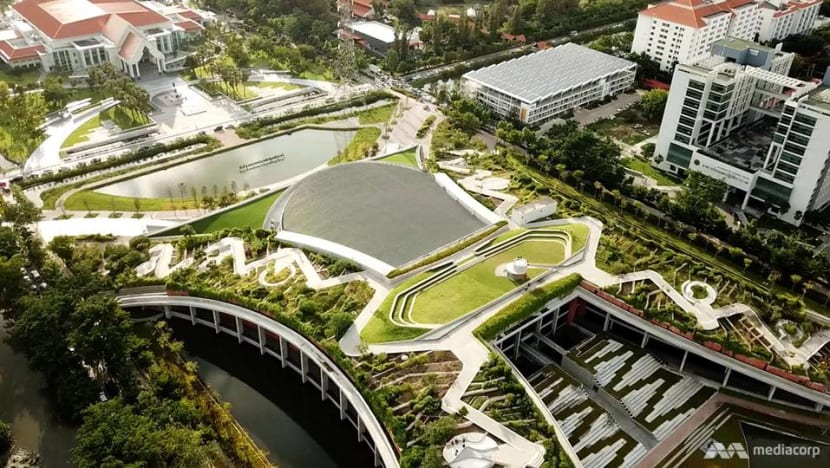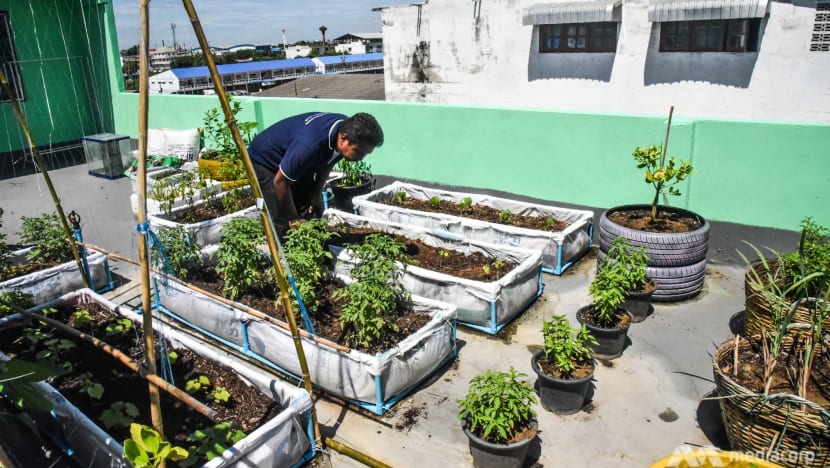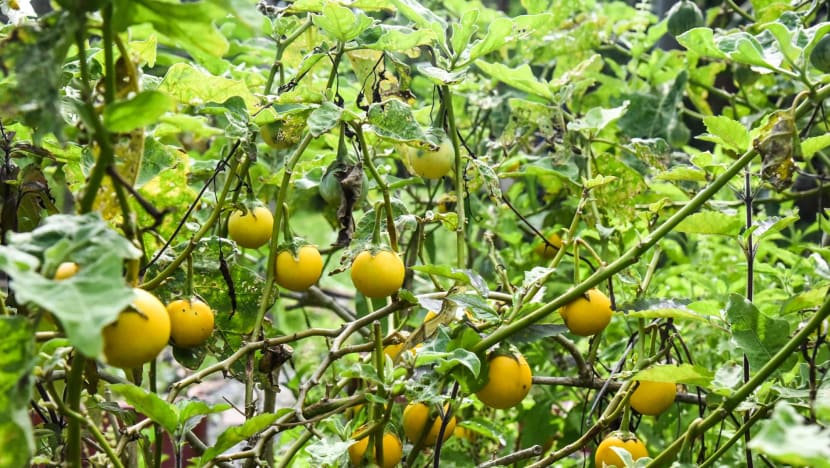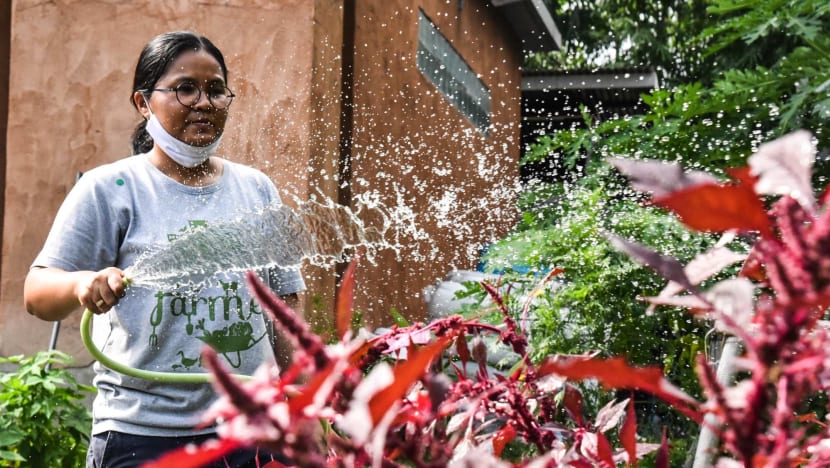In times of crisis, Bangkok is finding space to grow its own food

The rooftop at Thammasat University has cascading water capture systems in its design. (Photo: Jack Board)
BANGKOK: In a neighbouring province of the Thai capital, in one of the metropolis' hottest and most polluted industrial zones is not an obvious place to start a farming enterprise.
But above the dusty, busy streets in Samut Sakhon, a concrete space that before had done little except radiate heat is now a little oasis.
A sprinkler gently sprays water across beds of leafy plants and herbs and flowers. It is peaceful up here.
Importantly though, this rooftop garden has become a place of function and purpose for those who tend it. The building is home to the Migrant Worker Rights Network (MWRN), an organisation that provides legal and social assistance to vulnerable overseas workers.
When the COVID-19 pandemic struck, migrant workers were among those who lost their livelihoods and were unable to return to their home countries due to ongoing border restrictions.
Suthasinee Keawleklai, MWRN’s coordinator, soon saw a growing problem - these workers were going hungry.
“I noticed that people were starving because they had to cut their living expenses because they were furloughed and had lost their jobs. They had to do whatever it took to save money. They came to ask us for vegetable cuttings,” she said.

Instead of trying to find ways to donate food, she looked up. “A friend of mine who’s into organic farming suggested that we should grow more vegetables. I told my friend that there’s no space. My friend said ‘if you have a rooftop, it can be done’,” she recounted.
A few months on, about 30 migrants - mostly workers from Myanmar and their families - care for the garden themselves in their free time, transferring seeds, cleaning and watering the transformed space. And the vegetables have become a daily food staple during uncertain times.
“Whoever comes can just grab them This is what we do. We don’t separate who helps or who doesn’t help. If they come here, they can take the vegetables to eat,” said Ko Saw, a member of MWRN and now a keen gardener.
Rooftop gardens like this are not designed to be relied upon for food, but they can play an important role in filling gaps during times of crisis. Indeed, the COVID-19 pandemic has sparked interest in urban farming over the past few months.
In Thailand, looming concerns about food insecurity driven by climate change also means that urban farming is poised to be a crucial long-term resilience tool.

FALLING THROUGH THE CRACKS
The Thai City Farm project at the Sustainable Agriculture Foundation Thailand has been sharpening urban residents' farming skills for more than a decade. With a focus on the economically disadvantaged, especially slum communities, the project is aiming to build resilience among them.
Communities like the one in Samut Sakhon are the beneficiaries of guidance about how to set up their urban farm operations. Others are provided with soil and seeds to kickstart their planting ambitions.
Overall, Thai City Farm helps oversee more than 450 community projects, a number which has accelerated quickly in recent times with 210 new projects being launched during the COVID-19 period.
“There are so many people who fell through the crack because they have no food of their own and never learn how to grow. When they are out of a job, they have no money to buy food. They have to wait for donations,” said Varangkanang Nimhatta, the head of the project.
She says that the basic skills to grow food have largely disappeared from Bangkok’s urban fabric. It is expected to be a growing problem with the United Nations predicting that about 70 per cent of the global population will live in cities by 2050.
“Nowadays, it’s clear that urban people barely have any skills to produce food or truly understand the origin of their food, food-producing areas, or farmers,” Varangkanang said.
“Do we want people in the city to 100 per cent rely on themselves? No. But we want to rely on agricultural work in urban areas, as a tool, to make people learn basic skills.

“Apart from that, we think that learning to become a producer will make people understand the true origin of the food, and become a consumer who supports sustainable, organic, and natural agriculture, as well as agriculture that supports small farmers to be able to make a living, agriculture that does not destroy the environment and our surroundings,” she said.
It is a mantra shared by one of Bangkok’s pioneering urban farmers, Nakorn Limpacuptathavon, the “Veggie Prince”. He has been growing and promoting a sustainable urban lifestyle for more than 12 years and his backyard today in the district of Lat Prao is brimming with greenery.
“We want people to re-learn and re-connect with nature again,” he said. “A crisis is like a catalyst - a catalyst to awaken the people.
“The way to solve this problem is not hard. Everybody can do it.”

READ: Interest in urban farming sprouts in Singapore amid COVID-19 outbreak
READ: New company by Temasek, Bayer to develop vegetable seed varieties for vertical farming
BIG BUSINESSES CONTROL AGRICULTURE SECTOR
One of Thailand’s leading voices on food security says there’s a critical imbalance in the ways the country’s food is produced. Powerful conglomerates control much of the country’s agriculture sector, leaving farmers at the mercy of market prices and a centralised system.
It means there are fewer choices for consumers and less understanding about the delicate systems that generate the food that millions consume.
Witoon Lienchamroon, the founder of Biothai Foundation, says there is a prevailing myth that Thailand is the “kitchen of the world” where food will be forever plentiful.
To the contrary, the country remains in the grip of a damaging drought, which has resulted in sharp declines in rice and corn production and a drop in agricultural economic growth.
Additionally, around 6.5 million Thais suffer from malnutrition and hunger - including 600,000 children - while a further 5 million suffer from obesity, showing the clear inequalities that exist when it comes to food access and quality.
“Of course, there’s a food security problem in Thailand,” he said. “The source of food is no longer like it was in the past. In the past, people could grow their own food. Now, they have to buy from the market. And big companies have a bigger share in the market.”

READ: Commentary - From farmers to supermarket clerks, a new kind of essential worker has emerged
“We heavily rely on a few mass production food sources – not farmers. Food distributors and food producers are in the hand of big business chains.
“When this system of mass food production is integrated with food distribution, it causes climate change problems and pollution problems. The whole chain involves a lot of activities: using a lot of energy, water, machines, packaging production, trucks for transportation and so on,” he said.
BioThai is involved with promoting food safety and security, as well as promoting perennial vegetables that can be more sustainably grown and closing the links between farmer and consumer.
With climate change impacts worsening, cities like Bangkok are increasingly vulnerable to disruption in food supply. As rural areas suffer, it is the cities that go hungry, or face increased prices. In this regard, urban farming is a clear solution to help fill the gap, Withoon said.
Some of the benefits include reduced energy use, enhanced carbon sequestration from urban forests, the reuse of urban water and reducing the urban heat island effect, which is the increase of mean-day temperatures largely due to buildings and pavements, a factor to be further aggravated by climate change.

Places like Samut Sakhon and Rangsit, both near-satellite regions of Bangkok, were once home to important agricultural land. Now these areas form part of Bangkok’s sprawling urban shadow.
The result is a lost connection with the soil and the history of the area, says landscape architect and founder of urban design firm Landprocess, Kotchakorn Voraakhom.
“Over 50 years and you can see this big patch of concrete creeping out over the wetlands that used to be a channel for the river and how we drain our water from the north to the ocean. We used the best place to grow agriculture in the world to build the worst city in the world,” she said.
“From the beginning, we built the city in the wrong place but we cannot return. So now it’s about finding the right solution and changing the attitudes of the people.”
Kotchakorn has been a leading voice promoting functional green spaces in Bangkok’s new developments and converted spaces.

In Rangsit, at a campus for Thammasat University, Kotchakorn’s designs have given birth to Asia’s biggest rooftop garden.
The 22,000 sq m space recreates a rice terrace, includes micro-watersheds from its cascading roof and has expansive areas for students to grow organic vegetables and herbs. It has aesthetics but more critically, purpose.
“I think this building can create a solution to combine green space, food shortage problems and build the next generation of sustainable citizens, because this place is a university,” she said.
“This can really relate people back to the ground, even though it’s on the roof. Thinking about the land coverage, we covered the places that are supposed to be nature, supposed to be places to grow food.”
While she believes there is a disconnect at the moment between modern Bangkok residents and the land, which is rapidly being overtaken by urban fixtures, deep down people have an underlying desire to rediscover links to farming.
“We are actually growing from an agricultural culture. Farmers are our ancestors. So growing food and getting things as we walk from the trees is part of our culture and our landscape. So I feel that urban farming should be rooted in the new generation,” she said.
READ: Greener and cleaner - Reimagining our cities in the wake of COVID-19

Beyond these purpose-built green zones like at Thammasat, Withoon of Biothai wants unused space, which can be precious in crowded cities like Bangkok, to be unlocked for communities to farm.
“There are so many emptied lands. So, the government should change the law to facilitate urban farming ideas so that poor people can grow their food,” he said, giving the examples of district offices and temples as areas that could easily be converted for use, especially by poorer city residents.
Varangkanang of Thai City Farm added: “I think it’s been proven that if there’s space, whether it’s land or concrete or whatever it is, every place has the potential to produce food.” “People just need to start to do it.”
Additional reporting by Ryn Jirenuwat.














